by W.S. Cranshaw* (7/14)
Quick Facts…
- Hornworms are among the largest caterpillars found in Colorado.
- Although the “tomato hornworm” damages garden plants, most hornworm species cause insignificant plant injury.
- Adult stages of hornworms are known as sphinx, hawk, or “hummingbird” moths.
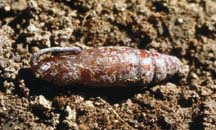
Hornworm pupa. |

Whitelined sphinx, a common “hummingbird” moth. |
Hornworms are among the largest of all caterpillars found in Colorado, some reaching lengths of three inches or more. Characteristically they sport a flexible spine (“horn”) on the hind end, although in some species this is lost and replaced with an eyespot marking. The most widely recognized hornworms are those that feed on tomatoes – the tomato hornworm and the tobacco hornworm. Although these two insects are considered garden pests, the majority of the more than 30 hornworm species found in Colorado are rarely observed and do not cause significant injury to plants.
Full-grown hornworm larvae migrate from their host plant and dig in loose soil where they pupate. Pupation occurs a few inches below the soil surface in a small chamber of packed earth. Pupae are typically brown, two inches or more in length, and many have a pronounced “snout” off the head end.
Adult stages of hornworms are heavy-bodied, strong flying insects known as sphinx or hawk moths. However, some local species are popularly known as “hummingbird moths”. These moths have a superficial resemblance to hummingbirds in flight while they similarly feed from deep-lobed flowers. The whitelined sphinx is the species most commonly observed in this habit and is usually most active during late afternoon and dusk. The great ash and twinspot sphinx are two other species commonly observed in “hummingbird moth” behavior. Adults of most hornworms (including the “tomato” hornworms) fly after dusk and are rarely observed except occasionally at porch lights.
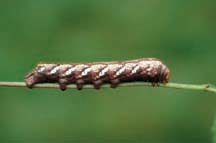
Achemon sphinx larva. |
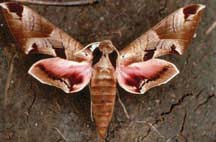
Achemon sphinx adult. |
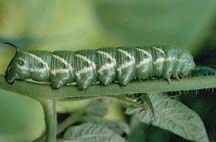
Tomato hornworm sphinx full-grown larva. |
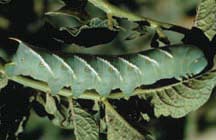
Tobacco hornworm full-grown larva. |
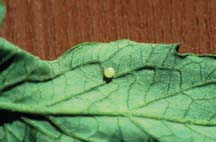
Hornworm egg. |
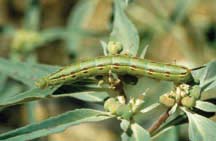
Whitelined sphinx larva. |
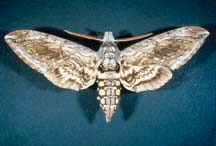
Tomato hornworm adult. |
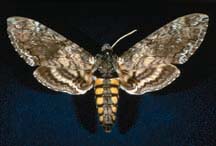
Tobacco hornworm adult. |
(Butterflies and Moths of North America, a Web site maintained by the USGS Northern Prairie Wildlife Research Center, documents the known distribution of various moths, including sphinx moths. It’s available at: www.npwrc.usgs.gov)
Life History and Habits
Whitelined Sphinx
The whitelined sphinx (Hyles lineata) is the most common hornworm of Colorado and, by far, the most commonly encountered “hummingbird moth”. Larvae develop on a variety of plants but seldom do they significantly damage those plants considered economically important. Portulaca, primrose, and wild grape are among the most common larval hosts. Rarely, you may see large outbreaks of caterpillars that sometimes result in very visible migrations across roadways when food plants are exhausted.
Hornworms of the whitelined sphinx can vary in color. Most are predominately green, with some yellow, white, and/or black markings. Less commonly you’ll find predominately black forms, with yellow markings. Adults have a prominent white band on the upper forewing.
“Poplar Sphinx Moths”
The largest common sphinx moth in Colorado is the big poplar sphinx (Pachysphinx occidentalis); a closely related species, the modest sphinx (Pachysphinx modesta), can be found in higher elevations. Caterpillars are generally green with light striping. Both species develop on aspen, cottonwood, poplar, and willow, but they are never abundant enough to cause injury to the tree.
Achemon Sphinx (“Hornless Hornworm”)
Larvae of the achemon sphinx (Eumorpha achemon) are unusual in that they lose the terminal “horn” after the first molt. Instead subsequent larval stages are marked by having a prominent “eyespot” marking at the hind end. The caterpillars develop on Virginia creeper, grape, and related vines and are dark brown with purplish tones. Apparently there is one generation produced per year, with full-grown caterpillars being observed in late August and early September.
“Tomato Hornworms”
The most familiar hornworms are those associated with tomatoes and related plants. This is a complex of two species, the tomato hornworn (Manduca quinquemaculata), and the tobacco hornworm (Manduca sexta). Both species are pests in vegetable gardens. The caterpillars chew leaves, and plants can be rapidly defoliated. Fruits may also be chewed. Tomatoes are particularly susceptible to injury; but other related plants, such as peppers and potatoes, are occasionally infested.
The tobacco hornworm is usually much more common in regional vegetable gardens than the tomato hornworm, but both may be found together as they generally have similar habits. The tomato hornworm has a dark green “horn” with black sides, while that of the tobacco hornworm is red. The caterpillars also are differentiated by the white striping along their sides. These form a series of V’s with tomato hornworms, while there are diagonal dashes on the tobacco hornworm. Occasional dark forms of the tomato hornworm larvae occur. The caterpillars of these are much darker than the normal green, although the adult moths differ little in appearance.
Many of the tomato and tobacco hornworms overwinter as pupae in the soil in the vicinity of previously infested gardens, typically emerging in late May and June. However, the adult moths are strong fliers that may travel long distances, with some apparently migrating into Colorado in late spring from more southerly areas. Female moths lay large pearl-colored eggs on the upper surface of leaves. The young caterpillars hatch and feed on the plant for a month or more. They have tremendous appetites
and consume large amounts of leaves as they grow older and larger. After feeding, they wander away from the plant and pupate in the soil. In southern areas of the region, a second generation frequently occurs with caterpillars present in late July and August and during warm summers.
Adult moths are identified by examining the hind wing which has two separate wavy bands next to the border on the tomato hornworm that are fused with the tobacco hornworm. The white marks on the abdomen of the tomato hornworm are also more angularly marked.
Control in Gardens
“Tomato” hornworms are easily controlled by garden insecticides (e.g., carbaryl, permethrin, spinosad). A biological control organism that is also highly effective and sold commonly is Bacillus thuringiensis (e.g., Dipel, Thuricide). Hornworm larvae can also be hand-picked although they are surprisingly difficult to detect because of their cryptic coloration. Larvae tend to feed on the exterior parts of plants during shadier periods, near dusk and dawn, when they may also be more readily observed and destroyed.
| Table 1. Some Common Hornworms Found in Colorado | ||
| Common Name | Scientific Name | Host Plants; Notes |
| Whitelined sphinx | Hyles lineata | Very wide host range that includes primrose, portulaca, apple, grape, four o’clock, and peonies. The adult is marked with strong white bands on the wing and is by far the most commonly encountered “hummingbird moth”. |
| Achemon sphinx | Eumorpha achemon | Grape, Virginia creeper, woodbine. These purplish-brown caterpillars lose the characteristic “horn” and have a dark eyespot in its place. |
| Tobacco hornworm/Carolina sphinx | Manduca sexta | Tomato, eggplant, and other nightshade family plants. The most common of the “tomato hornworms” east of the Rockies. |
| Tomato hornworm/Five-spotted hawkmoth | Manduca quinquemaculata | Tomato, eggplant, and other nightshade family plants. |
| Waved sphinx | Ceratomia undulosa | Ash, privet, oak, hawthorn. |
| Elm sphinx | Ceratomia amyntor | Elm. Birch, basswood, and cherry are occasional hosts. |
| Great ash sphinx | Sphinx chersis | Ash, lilac, privet. |
| Vashti sphinx | Sphinx vashti | Snowberry, other Symphoricarpos spp. Primarily west of the Rockies. |
| Big poplar sphinx | Pachysphinx occidentalis | Poplars, cottonwood, willow. This is the largest species found in much of the state. |
| Modest sphinx | Pachysphinx modesta | Poplars, aspen, willow. A large species but uncommon and confined to higher elevations. |
| Twinspot sphinx | Smerinthus jamaicensis | Poplar, birch, elm, willow, ash, apple. |
| One-eyed sphinx | Smerinthus cerisyi | Poplar, willow. |
| Snowberry clearwing | Hemaris diffinis | Honeysuckle, viburnum, hawthorn, snowberry, cherry, plum. Adults have clear wings and resemble oversized bumblebees. |
*Colorado State University Extension entomologist and professor, bioagricultural sciences and pest management. 3/02. Revised 7/14.
Colorado State University, U.S. Department of Agriculture, and Colorado counties cooperating. Extension programs are available to all without discrimination. No endorsement of products mentioned is intended nor is criticism implied of products not mentioned.
Go to top of this page.





